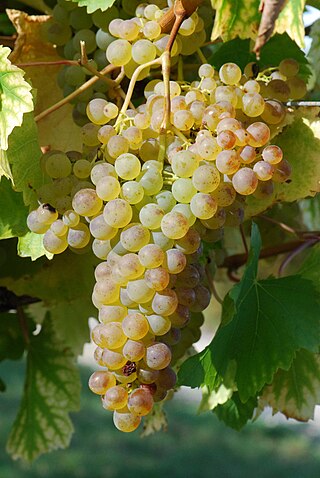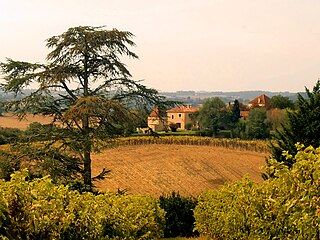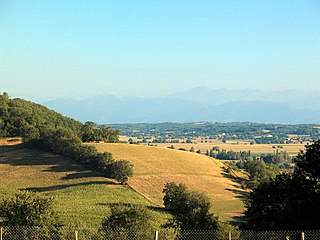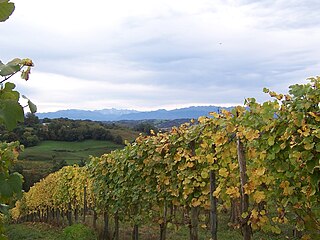
Colombard is a white French wine grape variety that may be the offspring of Chenin blanc and Gouais blanc. This makes the grape the sibling of the Armagnac Meslier-Saint-François and the nearly extinct Cognac grape Balzac blanc.

The Rhône wine region in Southern France is situated in the Rhône valley and produces numerous wines under various Appellation d'origine contrôlée (AOC) designations. The region's major appellation in production volume is Côtes du Rhône AOC.

Trebbiano is an Italian wine grape, one of the most widely planted grape varieties in the world. It gives good yields, but tends to yield undistinguished wine. It can be fresh and fruity, but does not keep long. Also known as ugni blanc, it has many other names reflecting a family of local subtypes, particularly in Italy and France. Its high acidity makes it important in Cognac and Armagnac productions.

Wine labels are important sources of information for consumers since they tell the type and origin of the wine. The label is often the only resource a buyer has for evaluating the wine before purchasing it. Certain information is ordinarily included in the wine label, such as the country of origin, quality, type of wine, alcoholic degree, producer, bottler, or importer. In addition to these national labeling requirements producers may include their web site address and a QR Code with vintage specific information.

Chambolle-Musigny is a commune in the Côte-d'Or département in eastern France.

French wine is produced all throughout France, in quantities between 50 and 60 million hectolitres per year, or 7–8 billion bottles. France is one of the largest wine producers in the world, along with Italian, Spanish, and American wine-producing regions. French wine traces its history to the 6th century BCE, with many of France's regions dating their wine-making history to Roman times. The wines produced range from expensive wines sold internationally to modest wines usually only seen within France such as the Margnat wines of the post-war period.
The Domaine de Bordeneuve is a French company, producing premium Armagnac brandy. The entire range of natural, craft Armagnacs is commercialised by Bordeneuve Châteaux & Collections

Lebanon is among the oldest sites of wine production in the world. The Israelite prophet Hosea is said to have urged his followers to return to God so that "they will blossom as the vine and fame be like the wine of Lebanon, [and] their fragrance will be like that of Lebanon". The Phoenicians of the coastal strip were instrumental in spreading wine and viticulture throughout the Mediterranean in ancient times.

Baron de Sigognac is an Armagnac brand produced by the Domaine de Bordeneuve company.

Provence (Provençal) wine comes from the French wine-producing region of Provence in southeast France. The Romans called the area provincia nostra, giving the region its name. Just south of the Alps, it was the first Roman province outside Italy.

Saint-Orens-Pouy-Petit is a commune in the Gers department in southwestern France.

Côtes de Gascogne is a wine-growing district in Gascony producing principally white wine. It is mainly located in the département of the Gers in the former Midi-Pyrénées region, and it belongs to the wine region South West France. The designation Côtes de Gascogne is used for a Vin de Pays produced in the Armagnac area. The decree of 13 September 1968 created the difference between a Vin de Pays and simpler table wine, the so-called Vin de table. The designation Côtes de Gascogne obliges the producers to respect the stricter rules and production standards, which were adopted with the decree of 25 January 1982.

South West France, or in French Sud-Ouest, is a wine region in France covering several wine-producing areas situated respectively inland from, and south of, the wine region of Bordeaux. These areas, which have a total of 16,000 hectares of vineyards, consist of several discontinuous wine "islands" throughout the Aquitaine region, and more or less to the west of the Midi-Pyrénées region.

Armagnac-Ténarèze is one of the three terroirs in the Armagnac region of France where grapes for the distillation of the Armagnac eau-de-vie can be cultivated. This area lies between Bas-Armagnac and Haut-Armagnac, covering the northwestern part of the department of Gers and the southern part of Lot-et-Garonne. Together the three areas form a single region where Armagnac can be produced.

Haut-Armagnac, one of the three terroirs in the Armagnac area where the grapes for the distillation of the Armagnac eau-de-vie can be cultivated. It lies to the south and east of Bas-Armagnac and Armagnac-Ténarèze, the two other areas, and is much the largest of the three.

The Floc de Gascogne is a regional apéritif from the Côtes de Gascogne and Armagnac regions of Sud-Ouest wine region of France. It is a vin de liqueur fortified with armagnac, the local brandy. It has had Appellation d'origine contrôlée status since 1990. Elsewhere in France analogous drinks are made.
Maison Louis Latour is a merchant and owner of red and white wines in Burgundy, France. It has remained independent and family-owned since 1797. Maison Louis Latour has the largest holding of Grand Cru in the Côte d'Or with a total of 28.63 hectares.
Roger I Armagnac was Viscount of Fezensaguet. He was the son of Bernard I, Viscount of Fezensaguet and Lomagne, and Geralda de Foix.
Maison Louis Max is a French wine producer from Burgundy, France founded in 1859 based in Nuits-Saint-Georges.
Robert Castagnon was an armagnac producer, publisher and founder of Circuit Paul Armagnac. He died in August 2004 at the age of 84 following a car crash.















